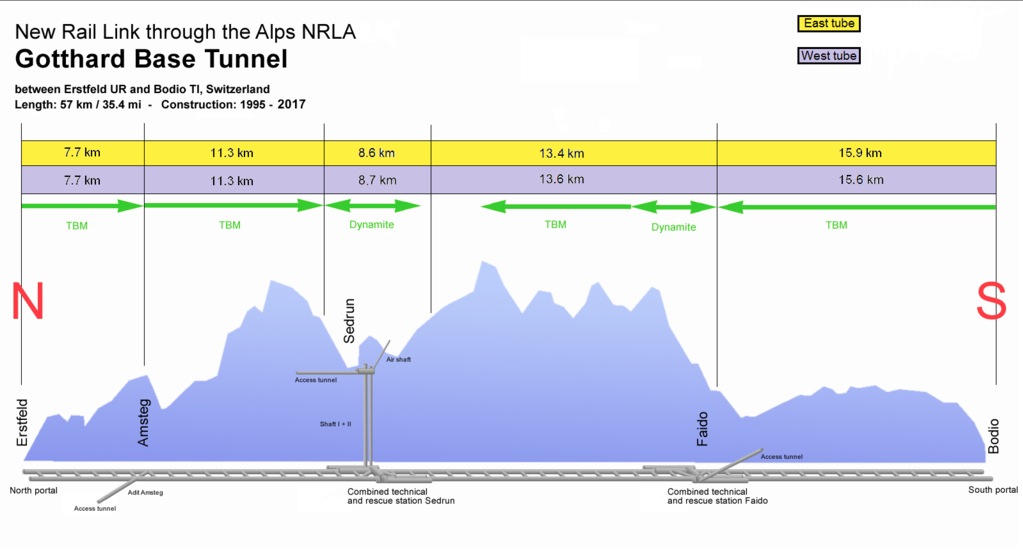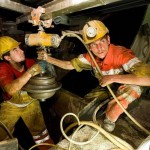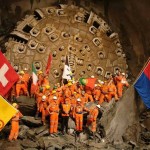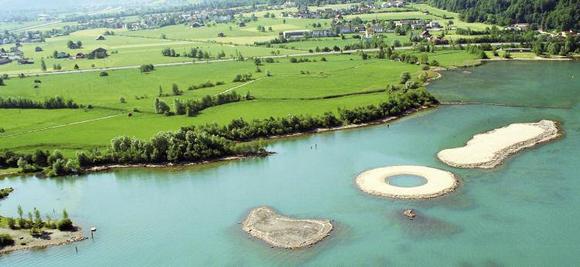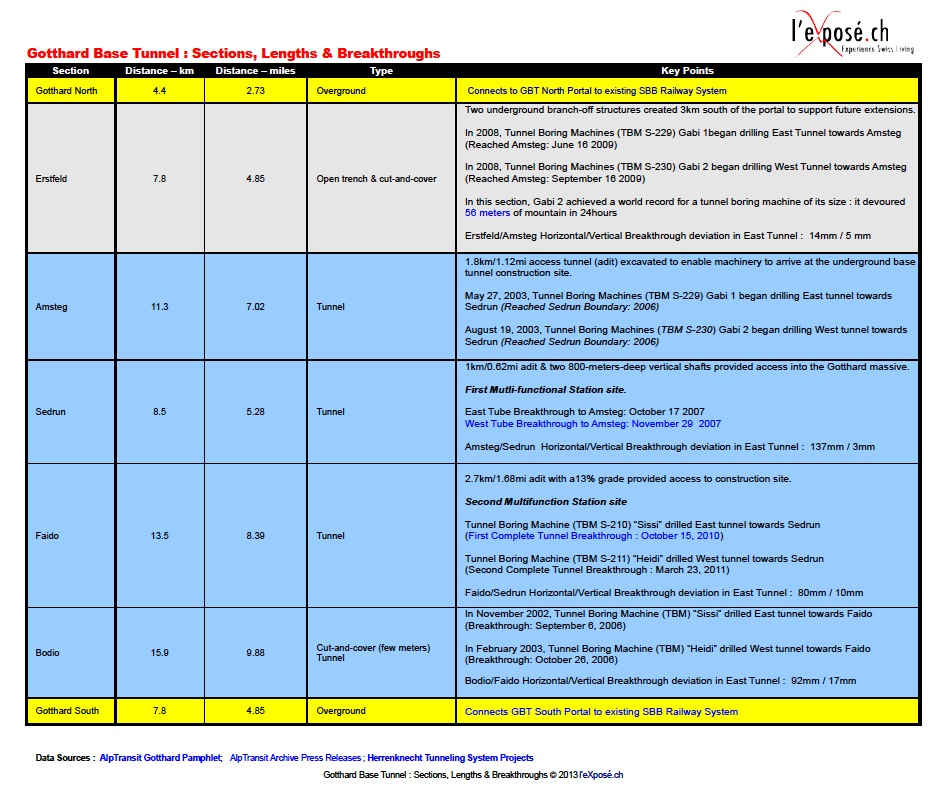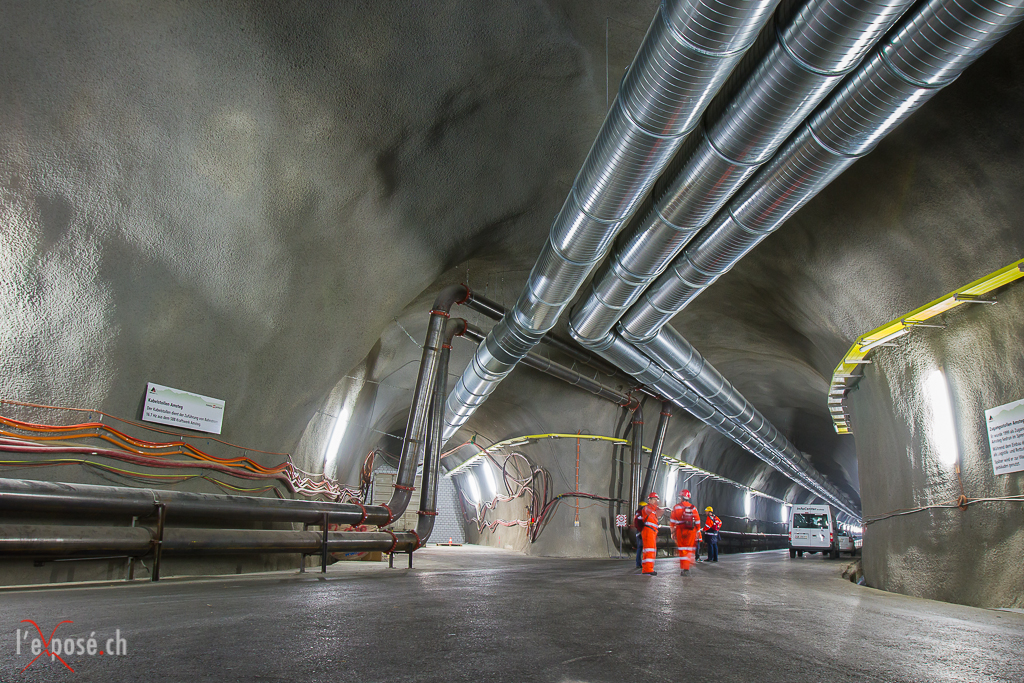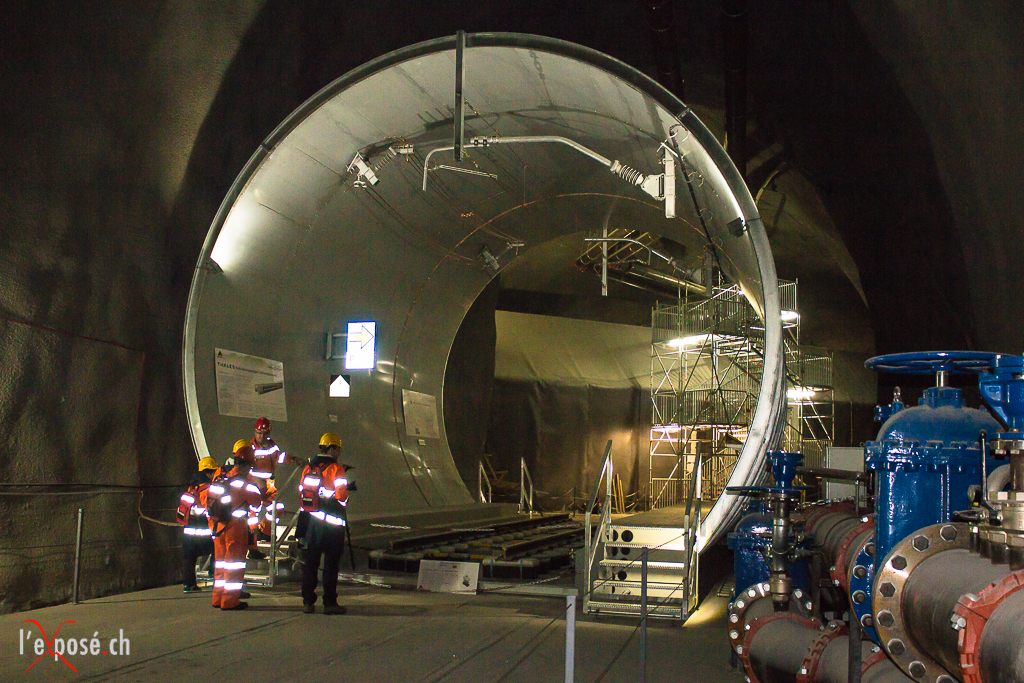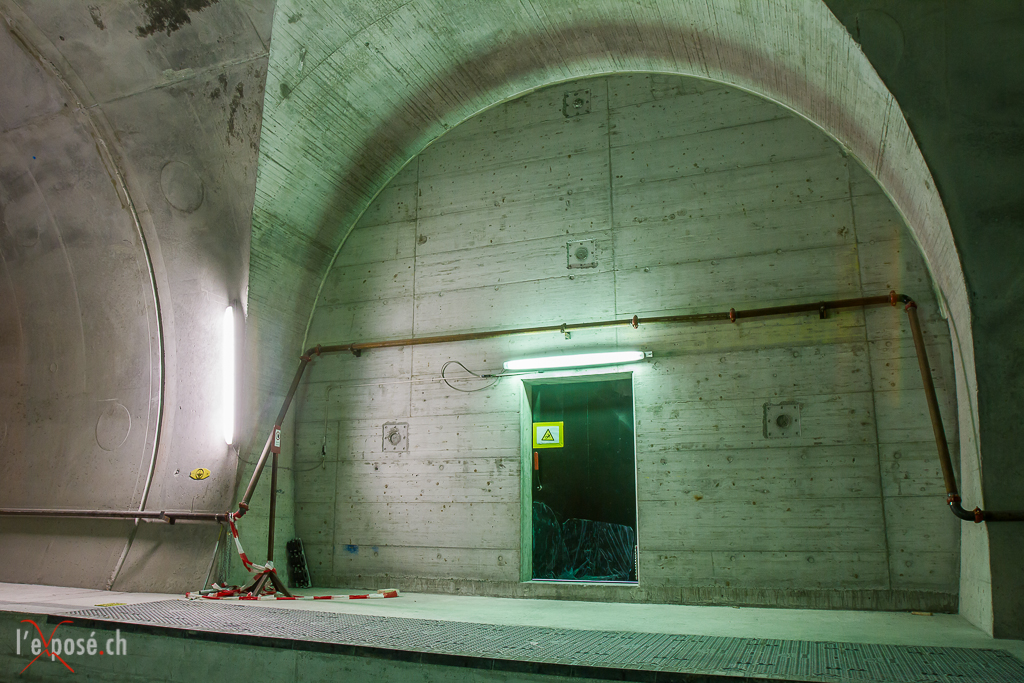Swiss innovations span many domains but are especially prolific in the field of civil engineering; this is evident by the many tourist attractions for which Switzerland holds a title:
- World’s Steepest Cogwheel Train — Mount Pilatus (1888)
- Europe’s First Mountain Railway — Vitznau-Rigi Bahn (1871)
- Europes Highest Outdoor Elevator — The Hammetschwand Lift (1905)
- World’s First Open Air Cable Car — Stanserhorn (2012)
- Europe’s Highest Suspension Bridge — Titlis (2012)
Swiss innovation in civil engineering, however, is most striking in the complex transportation network supporting daily life and the rapidly growing commerce activities through the Alps. In 1992, Switzerland embarked on an ambitious engineering program: NRLA — New Rail Link Through the Alps. The two most infamous projects in the program are the Lötscheberg Base Tunnel and the Gotthard Base Tunnel.
In 2007, the Lötschberg Base Tunnel (LBT) went into operation between Frutigen (Canton Bern) and Raron (Canton Valais). At 34.57km, it is currently the World’s Longest Land Tunnel! The main objective of LBT: reduce road congestion by transporting freight from Germany to Italy by rail and reducing commuter times between Bern and Valais. (Note: Although two tunnels were excavated, only one is fully operational).
In 2016-17, The Gotthard Base Tunnel at 57 km will surpass not only the Lötschberg Base Tunnel as the longest land tunnel in the world, but also the Japanese Seikan Submarine Tunnel (53.85km) as the world’s longest tunnel — period! The Gotthard Base Tunnel runs from Altdorf (Canton Uri) to Bodio (Canton Ticino) with the same objective as the LBT: reduce road congestion caused by the transport of goods and improve passenger traffic. (Note: The Ceneri Tunnel will eventually extend the route to Lugano — ETA 2019)
The NRLA program is a monumental feat of civil engineering spanning more than a quarter century with the Gotthard Base Tunnel its crowning achievement!
Approval
The original idea for a flat tunnel route traversing the Alps was first envisioned in 1947 by Carl Eduard Gruner of Basel. It would be more than 45 years before the Swiss population would vote in 1992 to accept the proposal for the New Rail Link through the Alps (NRLA). This decison formed the beginning of in-depth exploration, planning and execution for another exceptional achievement by the masters of civil engineering!
Route:
The Gotthard Base Tunnel (GBT) connects Altdorf (Canton Uri) in the North with Bodio (Canton Ticino) in the South. For construction and planning purposes, the route was divided into 7 sections: 5 under ground and 2 over land sections:
- Gotthard Nord,
- Erstfeld
- Amsteg
- Sedrun
- Faido
- Bodio
- Gotthard South
Structure:
Several major structures comprise the bones of the GBT:
- 57 km single track tube (East)
- 57 km single track tube (West)
- Sedrun Multifunction Station — 1/3 along the length of the tunnel ( Technical and Emergency)
- Faido Multifunction Station — 2/3 along the length of the tunnel ( Technical and Emergency)
- 176 cross passages — 1 every 325 meters ( Technical Equipment, Air Management, & Emergency Exits)
Planning:
A project lasting 25 years inevitably requires special handling. AlpTransit Gotthard Ltd, a subsidiary of SBB — future operator of the tunnels, was established in 1998 to oversee the project management and risk management activities. The actual work — planning and execution, was delegated to project engineers and subject matter experts.
To expedite development, work needed to be planned and executed in parallel. To support this goal, access tunnels (adits) were drilled at 3 locations: Amsteg, Sedrun, Faido. The purpose of the tunnels would be to move people, equipement and materials to the future construction sites.
Risks:
Challenges for the Gotthard Base Tunnel were numerous, but greatest among them were the unknown geological and hydrological conditions 2500 meters below the surface. Even with the most advanced technology, it’s impossible to predict with certainty what you’ll encounter until the driving begins. To mitigate the risks, exploratory bores were taken at the locations of greatest concern: Piora Syncline (Faido Section) and the Tavetsch Intermediate Massif (Sedrun Section).
Piora Syncline:
Exploratory work costing 100 million CHF was conducted between 1993 − 1996 to understand the scope of the Syncline challenge.
A 5.5km exploratory bore was cut by a tunnel boring machine to 350 meters above the planned tunnel level. A core bore taken in 1996 encountered sugary dolomite and water under high pressure. After recovering from an accident which flooded the tunnel with rock and water, boring began anew. 19 bores, totaling 7000 meters, would confirm stable dolomite anhydride & no water at the site of the future tunnel. As a further risk mitigation effort, a 300 meter core bore was taken from the East Tunnel in 2008 before penetrating the syncline, reconfirming the earlier results.
Tavetsch Intermediate Massif & Urseren-Gavera zone
The Sedrun section of the Gotthard Base Tunnel has been one of the most intriguing engineering challenges facing the project. The geographical position and geological landscape required innovative techniques to be developed and employed under extreme conditions.
Situation:
Sedrun resides between two unfavorable rock formations: Tavetsch intermediate massif (TZM North) and in the Urseren-Gavera zone (UGZ).
The UGZ was already well known as an intense pressure zone from difficulties (major plastic deformation) with the Gotthard Road Tunnel, 500 meters above & 15 meters West. The TZM was expected to be a similar, if not more difficult, situation. Furthermore, access to the levels of the future base tunnel and multifunction station (MFS) required two 800-meters-deep vertical shafts to be sunk. From there, a complex array of blasting and drilling would be necessary to ensure alignment with the work elsewhere along the GBT route and to excavate the various multi-level tunnels and galleries required by the MFS.
Evaluation:
To understand the conditions at the future site of the tunnels and MFS, a complex array of exploratory bores (including diagonal) , several reaching the level of the tunnel, were taken. The results were as follows:
- MFS at planned location would be OK
- UGZ impact possible in the southern most section of the MFS
- Kakiritic rock would be encountered North of the MFS
- Kakiritic rock is highly ductile & expands in volume when fractured
Solution:
To support the 800 meters of rock overburden, the final internal diameter of the tunnels needed to be 8 meters with an axial separation of 60 meters. To fulfill this requirement, two known methods were combined: the use of steel inserts in the form of deformable (sliding) rings and full face excavation with systematic strong support of the face. Although these techniques were not new, in combination and under such extreme conditions, they were considered groundbreaking.
To test the concept, a full scale prototype was installed in one of the side tunnels near to the actual installation location and by the same miners who would do the actual work. Water-filled cushions were used to simulate the pressure and test the behavior of the steel rings. It was evident when the rings were performing:
You could hear the movements of the ribs which give suddenly like rifle shots. That can worry miners and we wanted them to become accustomed to that because it is part of the system working.” Heinz Ehrbar, chief engineer for AlpTransit Gotthard. Source: New Civil Engineer
Conclusion:
Surprisingly, the MFS construction was not ultimately impacted by the UGZ. The zone was encountered nearly 500 meters further south than expected and no squeezing rock conditions had to be mastered in this area. The daily advancement rate thus increased from 1.1 meters to 1.9 meters providing a huge cost and schedule opportunity, but work to the North was as expected.
It is the great irony of the project that the most risky and complex sections we planned for should have been less difficult than thought, though not easy, and the easiest had so many problems and challenges,” says Heinz Ehrbar, chief engineer for AlpTransit Gotthard. Source: New Civil Engineer
(Click Image to View and Download PDF )
Surveying:
One of the many wonders of the GBT project was the amazing accuracy achieved at the excavation sites, breakthroughs within millimeters. Although the GBT is a “base” route, it is anything but a straight line. The route accommodates the natural and artificial landscape ie. villages, highways, power stations etc. To achieve necessary accuracy, several surveying techniques were used and conditions continually accessed.
With the helps of satellites, fixed points were mapped to the plans and surface terrain along the entire route. Using the “traverse principle” , these points were then used to mark the underground tunnel .
Surveying efforts inside the GBT were a logistical challenge given the multiple works sites, side channels and 24hour work schedules. In addition, tunnel distortion was continually a factor because of temperature changes and rock burden.
Although high tech surveying equipment was employed (Tacheometer, Surverying Gyroscope, Laser Scanners), the Sedrun shafts were especially problematic. Transmission of the position and directional data from the surface of the shafts to the level of the tunnel was extremely difficult. The issue was overcome with mechanical and optical plumbing systems and surveying gyroscopes.
The accuracy of the breakthrough deviations along the GBT is testimony to the attention and skill applied to the surveying efforts:
Tunnel Lining:
The Gotthard Base Tunnel has been designed to endure 100 years. This life-span requirement was incorporated into the structural design and the materials choosen.
The varying geological formations required a modular system of supporting structures of different strengths and styles – anchors, shotcrete, steel arches, and in some cases: diamond screens, pipe screens, drainage bores and injections.
A double shell design was selected for water ingress management and to provide a smooth outer surface. In addition, special sealing foil was required to cope with the high humidity and rock temperatures that could reach 50°C*.
The concrete aggregate for the inner layer, composed on site by the excavated rock, is 30 cm thick and another innovation! Various experiments were required to achieve the appropriate level of quality as rock from tunnel boring machines is not normally sufficient for this purpose
* Watercooling systems were installed to easy working conditions. Hightech ventilations system in the cross passage will help control tunnel climate during operation: 36°C in the summer and 35° in Winter.
Tunnel Boring Machine:
Perhaps one of the more visually stunning technologies employed in the GBT is the Gripper Tunnel Boring Machines (TBM) by Herrenknecht Tunneling Systems.
Although traditional drilling and blasting methods were the only option at Sedrun, 4 tunnel boring machines (TBM) at 30 million CHF a peice were employed for the long drives in Erstfeld, Amsteg, Faido and Bodio.
The Gripper Tunnel Boring machines are amazing feats of engineering. Used in projects around the world, they are experts at devouring rock. The cutting heads plus the driving equipment is 450 meters long! 3 different diameter cutter-heads were used (8.83m, 9.43m, 9.58m) with disk cutters that could be changed based on the type of rock encountered. The machines are capable of not only capturing, transporting and processing material but also installing the tunnel support systems. Pushed along on rails, the machines are able to make “fast” work of tunnel excavation over long distances.
The most famous of the 4 TBM’s used in the GBT is “Sissi”. “Sissi” is the name of the cutterhead responsible for the first complete break-through in the East tunnel on October 15, 2010. In 2012, “Sissi” was placed at the entrance of the Transportation Museum in Lucern as testimony to the Gotthard Base Tunnel Project and this incredible technology.
(Click Image to View and Download PDF )
Impact:
There are many questions which cross the mind when “studying” the GBT project. One of them would undoubtedly be: “What impact will this project have on the environment” ? The terrain in this region of Switzerland is exceptionally beautiful and wanting to protect it was of paramount concern to the government and the people. The constant grid-lock over the Gotthard, especially in Summer, was one of the reasons for approving the NRLA program.
Undoubtedly, “damage” occurs when blasting and drilling mountains to build highways and tunnels. The AlpTransit and the partners understood this and employed several dampening and restorative programs to mitigate the effects. Among these efforts:
- All work vehicles and machines were equiped with particle filters
- Waste water was purified and cooled before being returned to the rivers
- Irrigation systems and barriers were created and hours of operation restricted to mitigate dust and noise
- Flora and Fauna that were destroyed have and/or will be replaced, streams “renatured” and banks naturalised
- Recycling the 28million tons of the rock removed during excavation:
— Reused to make the tunnel linings
— Landscaping material and embankments
— Material unsuitable for “recycling” (1.8million tons) was partially used to create 3 nature reserves and 3 bathing islands in the shallow water zone at the tip of Lake Uri ( branch of Lake Lucerne in Canton Uri)
— A “small portion” will inevitably end up in landfills.
Status & Statistics:
As of February 1, 2013, the Gotthard Base tunnels are fully excavated and the installation of the railway infastructure is 36% complete. The project is reportedly on cost and schedule — a remarkable accomplishment! 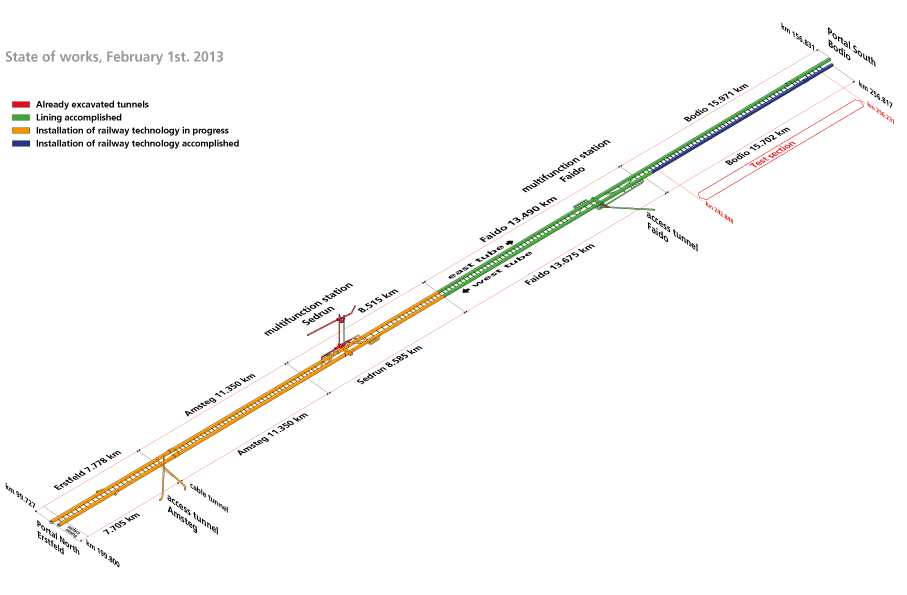
Key Statistics for the Gotthard Base Tunnel:
- 57km – Total Tunnel Length
- 40m — Separation Between Tunnels
- 28°C — Maximum Work Temperature
- 50°C — Maximum Temperature of Rock
- 2600 — No of Persons Employed
- 2300m — Maximum Rock Overburden
- 28 million tons — Total volume of excavated rock
- 75% — Drilling by Tunnel Boring Machines
- 25% — Traditional Drilling and Blasting
- 200 − 260 — No of Trains per day compared to 140 − 180 currently
- 50 million tons — Annual Volume of Freight Transport (2.5x the current volume of 20million)
- 160km/h — Speed of Freight Trains
- 250km/h — Speed of Passenger Trains
- 1.5hours — Projected Commute Time between Zurich to Ticino (Dependent on approach routes & network expansion)
- < 3hours — Projected Commute Time between Zurich to Milan (Dependent on approach routes & network expansion)
Final Thoughts:
To visit the Amsteg construction site and see the progress of the Gotthard Base Tunnel and infastructure development was to stand inside “history-in-the-making”. I am not normally enthralled by feats of engineering and ones which blast holes in mountains, but I appreciate the sheer genius behind the effort and the project management efforts which support it! And now, I hold onto the hope that the NRLA program will truly be an endeavor that helps preserve the beauty of the Alpine region for generations.
Visiting the Gotthard Base Tunnel:
Visits can be arranged from different sights, but the guided tour from Erstfeld to Amsteg was in German only. To learn more about the Visitor Centers, Guided Tours and Open Construction Site Days, contact AlpTransit AG .
Major Milestones: Chart and Infographic
Summary of the Gotthard Base Tunnel section lengths, breakthrough dates and deviations:
Gotthard Base Tunnel: Sections, Lengths & Breakthroughs summarizes key figures and dates.
(Click to View and Download PDF )
The INFORGRAPHIC captures the major milestones for the Gotthard Base Tunnel Project
(Click to view larger format )
Tunnel Visit:
Photos taken during a visit to the Gotthard Base Tunnel Amsteg Section in January 2013.
Important: All photos from the visit belong to l’eXposé.ch. Credit should be appropriately attributed.
Resources:
The following is a list of several resources used to construct this article: “Gotthard Base Tunnel: A Swiss Innovation” :
Source: BLS NRLA Overview
Source: Japanese Seikan Submarine Tunnel Wikipedia
Source: AlpTransit Gotthard: New Traffic Route through the heart of Switzerland
Source: AlpTransit: Risk Management for the World’s Longest Railway Tunnel — Lesson’s Learnt
Source: New Civil Engineer; “Between a Rock and a Hard Place” 27 January 2011
Source: AlpTransit AG Press Release Archives
Source: AlptTransit AG: Raw Construction Facts and Figures
Source: Herrenknecht Tunneling Systems — Gotthard Base Tunnel Project
Source: “ Design of inner lining at the Gotthard Base Tunnel, approach for the evaluation of loads, the different types of lining” R. Stadelmann, A. Pfeffer & Z.Q. Wei


